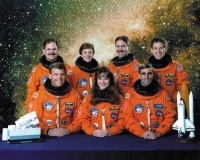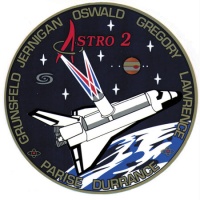STS-67
From The Space Library
 | |
| Organization | NASA-Office of Space Flight (United States) |
|---|---|
| Mission type | Astronomy,Human Crew |
| Launch date | March 2, 1995 |
| Launch vehicle | Space Shuttle |
| Launch site | Cape Canaveral, United States |
| COSPAR ID | 1995-007A |
| Inclination | 28.45 degrees |
| Experiments | Here |
| Alternate Names | 23500 |
| Additional Information | Here |
| Data Collection | Here |
| Payload Mass Up | 13116 kg |
| Payload Mass Down | 13143.64 kg |
| Orbiter | Endeavour |
| Lift Off Mass | 2,054,902.27 kg |
| Orbiter Weight at Liftoff | 116,496.82 kg |
| Orbiter Weight at Landing | 99,085.91 kg |
| Landed | Concrete runway 22 at Edwards Air Force Base, Calif. |
| Orbits of Earth | 263 |
| Orbital Altitude | 190 nautical miles (219 statute miles) |
Contents |
[edit] Crew
- Commander: Stephen S. Oswald
- Pilot: William G. Gregory
- Payload Commander: Tamara E. Jernigan
- Mission Specialist 1: John M. Grunsfeld
- Mission Specialist 2: Wendy B. Lawrence
- Mission Specialist 3:
- Mission Specialist 4:
- Mission Specialist 5:
- Payload Specialist 1: Samuel T. Durrance
- Payload Specialist 2: Ronald A. Parise
ISS/Mir Crew Transport
[edit] Mission
STS 67 was a US Shuttle spacecraft launched from Cape Canaveral. The main cargo on board was the Astro 2 Spacelab that carried 3 UV telescopes. Astro-2 was the second dedicated Spacelab mission to conduct astronomical observations in the ultraviolet spectral regions. It consisted of three unique instruments - the Hopkins Ultraviolet Telescope (HUT), the Ultraviolet Imaging Telescope (UIT) and the Wisconsin Ultraviolet Photo-Polarimeter Experiment (WUPPE). These experiments will select targets from a list of over 600 and observed objects ranging from some inside the solar system to individual stars, nebulae, supernova remnants, galaxies and active extragalactic objects. These data will supplement data collected on the Astro-1 mission flown on STS-35 in December 1990 aboard Columbia. Because most ultraviolet radiation is absorbed by Earth's atmosphere, it cannot be studied from the ground. The far and extreme ultraviolet region of the spectrum was largely unexplored before Astro-1, but knowledge of all wavelengths is essential to obtain an accurate picture of the universe. Astro-2 will have almost twice the duration of its predecessor, and a launch at a different time of year allows the telescopes to view different portions of the sky. The mission promises to fill in large gaps in astronomers' understanding of the universe and lay the foundations for more discovery in the future. On the Middeck, science experiments included the Protein Crystal Growth Thermal Enclosure System Vapor Diffusion Apparatus-03 experiment (PCG-TES-03), the Protein Crystal Growth Single Thermal Enclosure System-02 (PCG-STES-02), the Shuttle Amateur Radio Experiment-II (SAREX-II), the Middeck Active Control Experiment (MACE), the Commercial Materials Dispersion Apparatus Instrumentation Technology Associates Experiments-03 (CMIX-03) and the Midcourse Space Experiment (MSX). The Middeck Active Control Experiment (MACE) was a space engineering research payload. It consisted of a rate gyro, reaction wheels, a precision pointing payload, and a scanning and pointing payload that produces motion disturbances. The goal of the experiment was to test a closed loop control system that will compensate for motion disturbances. On orbit, Commander Stephen S. Oswald and William G. Gregory used MACE to test about 200 different motion disturbance situations over 45 hours of testing during the mission. Information from MACE will be used to design better control s ystems that compensate for motion in future spacecraft. Two Get Away Special (GAS) payloads were also on board. They were the G-387 and G-388 canisters. This experiment was sponsored by the Australian Space Office and AUSPACE ltd. The objectives were to make ultraviolet observations of deep space or nearby galaxies. These observations will be made to study the structure of galactic supernova remnants, the distribution of hot gas in the Magellanic Clouds, the hot galactic halo emission, and emission associated with galactic cooling flows and jets. The two GAS canisters were interconnected with a cable. Canister 1 had a motorized door assembly that exposes a UV telescope to space when opened. UV reflective filters on the telescopes optics determined its UV bandpass. Canister 2 contained two video recorders for data storage and batteries to provide experiment power.
[edit] EVA
[edit] Payload
Ultraviolet Astronomy (ASTRO) 2; Middeck Active Control Experiment (MACE); Protein Crystal Growth - Thermal Enclosure System (PCG-TES) 03; Protein Crystal Growth - Single-Locker Thermal Enclosure System (PCG-STES) 02; Commercial Materials Dispersion Apparatus Minilab/Instrumentation Technology Associates, Inc. Experiments (CMIX) 03; Shuttle Amateur Radio Experiment (SAREX) II; two getaway special experiments
[edit] Books about the Space Shuttle Program
Buy This Book Click here |
Buy This Book here |
Buy This Book Click here |
Buy This Book Click here |





